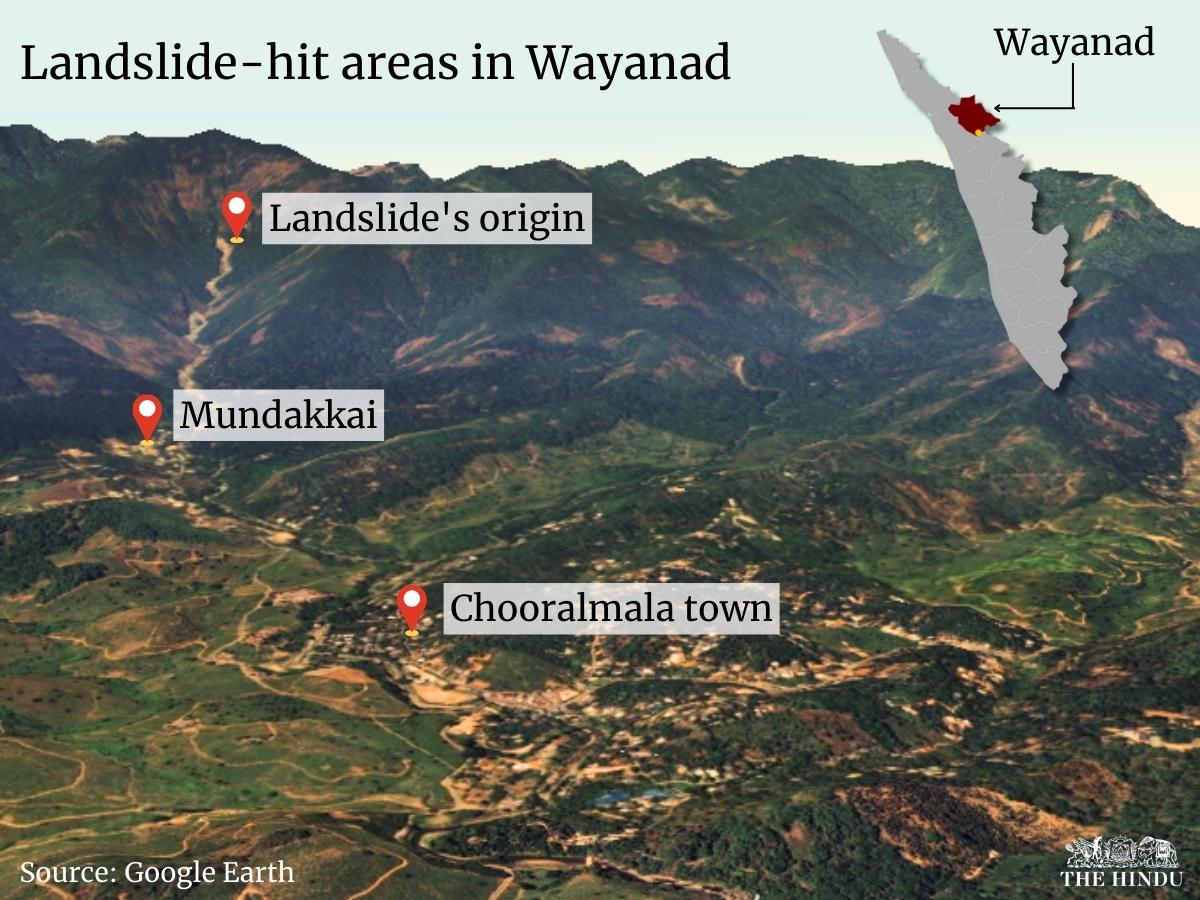Landslides in Wayanad
Background:

- In the early hours of July 30, 2024, Chooralmala and Mundakkai villages in the district of Wayanad in Kerala were hit by devastating landslides triggered by torrential downpour. The massive landslides so far has claimed over 400 lives.
What is a landslide?
- Landslides are natural phenomena that usually occur in mountainous regions with steep slopes.
- During a landslide, large amounts of rock, boulders, loose mud, soil, and debris roll down slopes and hillsides, gathering great momentum and often taking vegetation or buildings along.
- Landslides are seen as being caused by two factors,
- Conditioning factors are underlying conditions or characteristics of a specific area that make it more susceptible or vulnerable to certain events, such as landslides.
- Triggering factors are the immediate causes or events that initiate a landslide, acting on the pre-existing vulnerabilities created by conditioning factors.
- While conditioning factors make an area susceptible to landslides, triggering factors are the events that actually set the landslide in motion.
Reasons behind Wayanad landslide:
Conditioning Factors:
- Topography and Slope: The steep slopes and mountainous terrain of Wayanad make it naturally susceptible to landslides.
- Soil and Geology: The area’s soil composition, which becomes easily saturated with water, combined with the underlying rock formations, contributes to the likelihood of landslides.
- Geomorphology: The region’s geomorphological features, including its natural drainage patterns and the presence of loose, weathered material on slopes, make it more vulnerable to landslide events.
Triggering Factors:
- Intense Rainfall: The region experienced two weeks of continuous rainfall, 50-70% above normal, which saturated the topsoil. This was followed by a day of extremely heavy rainfall, akin to a mini cloudburst, which triggered the landslide.
- Deforestation and Land Use Change: The cutting down of large, native trees for plantations (like tea and coffee) has weakened the soil structure. These crops have shallow roots, which are less effective at holding the soil to the bedrock, contributing to the instability of the slopes.
- Agricultural Practices (Monocropping): The practice of monocropping in the area, particularly the replacement of native vegetation with plantation crops, has further destabilised the land.
- Anthropogenic Activities: Human activities, such as unplanned construction, road-building, and other development projects, have disturbed the natural landscape, increasing the risk of landslides.
- Atmospheric Conditions: Specific atmospheric conditions, such as the mesoscale organisation of large convective cloud clusters, have led to extremely heavy rainfall in short periods, heightening the risk of landslides.
Measures to Reduce Landslide incidents:
-
- Implement Sustainable Land Use and Development Practices: Enforce strict regulations on construction and land development in ecologically sensitive areas.
- Avoid building on steep slopes and ensure that any development projects, such as roads, buildings, and plantations, are conducted with proper geological assessments and environmental impact studies.
- Implement Sustainable Land Use and Development Practices: Enforce strict regulations on construction and land development in ecologically sensitive areas.
- Afforestation and Vegetation Management: Restore and maintain native vegetation on slopes, which helps to stabilise the soil with deep-rooted plants.
- Avoid replacing native forests with shallow-rooted crops or monoculture plantations that provide less soil stability.
- Improve Drainage Systems: Construct effective drainage systems to manage surface runoff and prevent water accumulation, which can saturate the soil and trigger landslides.
- This includes installing proper drainage channels on roads and ensuring that agricultural fields have adequate drainage to avoid waterlogging.
- Community-Based Monitoring and Early Warning Systems: Establish local monitoring programs and early warning systems to detect signs of potential landslides, such as ground movement or cracks.
- Involve local communities in these efforts to ensure timely evacuation and response during heavy rains or other triggering events.
- Promote and Implement Conservation Policies: Enforce recommendations from ecological studies, such as those from the Madhav Gadgil Committee, to protect high-risk areas by designating them as Ecologically Sensitive Zones (ESZ).
- This includes restricting harmful activities like mining, quarrying, and deforestation in these zones to reduce the risk of landslides.
Conclusion:
- In the coming years, we are likely to witness more and more extreme weather events, intensifying vulnerabilities in disaster-prone states like Kerala.
- Our people deserve the infrastructure, political will, and environmental policies that take into account their needs and livelihoods.
Subscribe
Login
0 Comments
